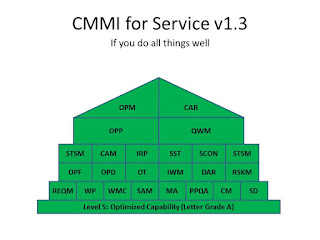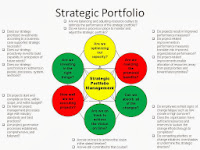CMMI for Service as Process Improvement
Capability maturity models answer the question: What are the characteristics of a high functioning organization? The defacto standard maturity model is managed by SEI (http://www.sei.cmu.edu/) and provides a detailed description of what highly mature organizations do.
As a process improvement tool, a CMMI model provides a standard against which the baseline organization can be compared. Any gaps between the standard and the baseline organization points the way for future improvement plans. The value of the model lies in the assessment material; it forces you to look across a broad array of processes and compare your organization to a consistent standard. Because the standard does not change, any reduction in gaps between the baseline and the standard represents progress for your organization.
The summary graphic shown here is my depiction of the CMMI for Service standard. It consists of 24 must-do processes that define a highly mature organization. Each abbreviation brick represents an important process area for a mature organization. As an example, the REQM brick represents requirements management.
Each brick in the pyramid is kind of like an individual assignment. You score the brick 0-3 based on how well your organization accomplishes that process. Then you combine scores on all of the bricks to determine your final grade -- your capability maturity level which is scored 1-5 (or F to A).
To conduct a formal CMMI assessment can be a monstrous undertaking that requires payment to outside assessors. In my organization, we are planning to start with an internal and informal assessment -- just to get us started and establish a baseline. We are the process now of translating the CMMI materials into focus questions for our organization.
As a process improvement tool, a CMMI model provides a standard against which the baseline organization can be compared. Any gaps between the standard and the baseline organization points the way for future improvement plans. The value of the model lies in the assessment material; it forces you to look across a broad array of processes and compare your organization to a consistent standard. Because the standard does not change, any reduction in gaps between the baseline and the standard represents progress for your organization.
The summary graphic shown here is my depiction of the CMMI for Service standard. It consists of 24 must-do processes that define a highly mature organization. Each abbreviation brick represents an important process area for a mature organization. As an example, the REQM brick represents requirements management.
Each brick in the pyramid is kind of like an individual assignment. You score the brick 0-3 based on how well your organization accomplishes that process. Then you combine scores on all of the bricks to determine your final grade -- your capability maturity level which is scored 1-5 (or F to A).
To conduct a formal CMMI assessment can be a monstrous undertaking that requires payment to outside assessors. In my organization, we are planning to start with an internal and informal assessment -- just to get us started and establish a baseline. We are the process now of translating the CMMI materials into focus questions for our organization.



Comments
Post a Comment